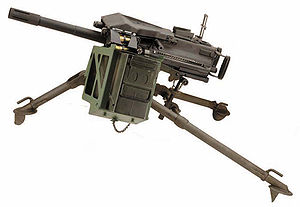MK19 grenade launcher
| Mk 19 grenade launcher | |
|---|---|

A Mk 19 40 mm grenade launcher mounted on an M3 tripod
|
|
| Type | Automatic grenade launcher |
| Place of origin | United States |
| Service history | |
| In service | 1968–present |
| Used by | See Users |
| Wars | |
| Production history | |
| Designer | Naval Ordnance Station Louisville |
| Designed | 1966 |
| Manufacturer | Saco Defense Industries (now a division of General Dynamics Ordnance and Tactical Systems), Combined Service Forces, MKEK |
| Unit cost | $20,000 |
| Produced | 1968–present |
| Variants | Mk 19 Mod 0, Mk 19 Mod 1, Mk 19 Mod 2, Mk 19 Mod 3, Mk 19 Mod 4 |
| Specifications | |
| Weight | 77.6 pounds (35.2 kg) (empty, without accessories) |
| Length | 43.1 inches (1,090 mm) |
| Barrel length | 16.25 inches (413 mm) |
| Width | 9.46 inches (240.4 mm) |
| Height | 7.8 inches (199 mm) |
|
|
|
| Cartridge | 40×53 mm |
| Action | Blowback (Advanced primer ignition) |
| Rate of fire | 40 rpm (sustained) 60 rpm (rapid) 325–375 rpm (cyclic) |
| Muzzle velocity | 790 feet per second (241 m/s) (average) |
| Effective firing range | 1,500 m (1,600 yd) |
| Maximum firing range | 2,212 m (2,419 yd) |
| Feed system | 32- or 48-grenade belt |
The Mk 19 grenade launcher (pronounced Mark 19) is an American 40 mm belt-fed automatic grenade launcher that was first developed during the Vietnam War. The first model (Mod 0) in 1966 was determined to be unreliable and unsafe, but a total of six Mod 1 launchers were successfully tested on U.S. Navy riverine patrol craft in the Mekong Delta in 1972. The Navy made further improvements to the weapon, resulting in the Mod 3 in 1976. The Mod 3 was adopted by the U.S Army in 1983 and remains in service to the present day.
The Mk 19 is a belt-fed, blowback-operated, air-cooled, crew-served, fully automatic weapon that is designed not to cook off. It fires 40 mm grenades at a cyclic rate of 325 to 375 rounds per minute, giving a practical rate of fire of 60 rounds per minute (rapid) and 40 rounds per minute (sustained). The weapon operates on the blowback principle, which uses the chamber pressure from each fired round to load and re-cock the weapon. The Mk 19 can launch its grenade at a maximum distance of 2,212 meters (2,419 yd), though its effective range to a point target is about 1,500 meters (1,600 yd), since the large rear leaf sight is only graduated as far. The nearest safe distance to launch the grenade is 310 meters in training and 75 meters in combat. Though the Mk 19 has a flash suppressor, it serves only to save the eyesight of its operator, not concealing the weapon's position. For night operation, a picatinny rail quadrant sight can be added for thermal and night vision optics.
The Mk 19A is a man-portable crew-served weapon that can fire from a tripod-mounted position or from a vehicle mount, with the latter being the preferred method, as the weapon alone weighs 77.6 pounds (35.2 kg). The primary ammunition for it is the high-explosive dual-purpose M430 grenade. On impact, the grenade can kill anyone within a radius of five meters, and wound them within a radius of 15 meters. It can also punch through 2 inches (5.1 cm) of rolled homogeneous armor with a direct hit (0-degree obliquity), which means it can penetrate most infantry fighting vehicles and armored personnel carriers. It is especially effective when used against enemy infantry formations. The ammunition comes in cans that hold a 32- or 48-grenade belt weighing 42 and 60 pounds (19 and 27 kg), respectively. Due to its low recoil and comparatively light weight, it has been adapted for use on many different platforms, including small attack boats, fast attack vehicles such as the Humvee (HMMWV), AAV and Stryker, military jeeps, and a large variety of naval mounts.
...
Wikipedia
